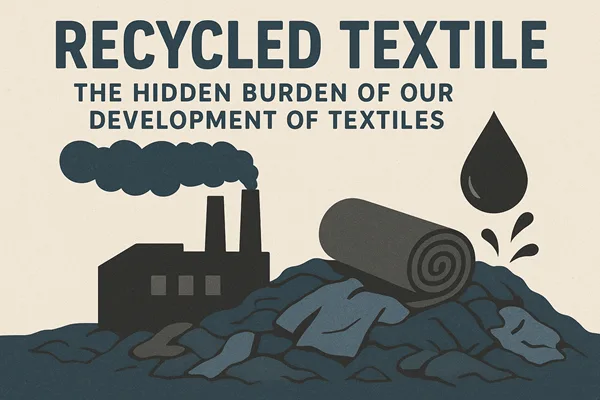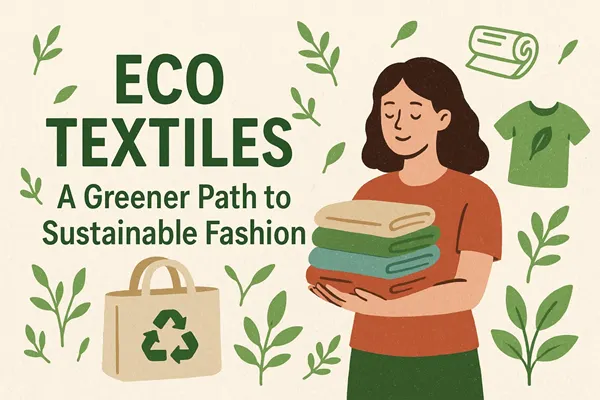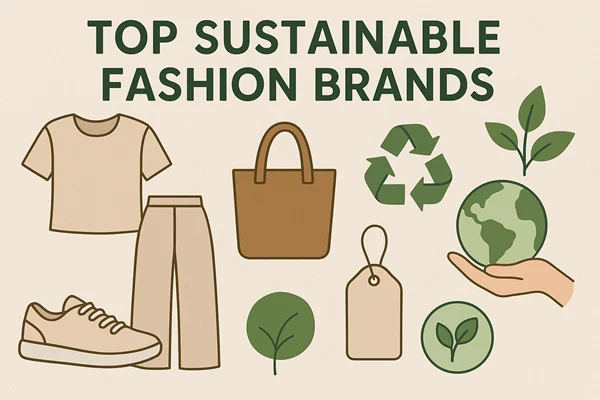Recycled Textile: The Hidden Burden of Our Development of Textiles
The demand for textiles is increasing day by day, and along with meeting this demand, the amount of textile waste is also increasing. From there, the gas and chemical leachates that emerge during the decomposition process pollute the air, soil, and groundwater and negatively impact the environment and health of humans and other species. These wastes are a serious threat to the environment. A logical approach to diverting the existing textile waste stream is the adoption of textile recycling technologies and systems. This article is all about the Hidden Burden of Our Development of Textiles, which is that of Recycled Textile.
Introduction:
The development of the textile industry is depending on the decrease of waste management. Worldwide, 75% of textile waste is landfilled, only 25% is recycled or reused. It is too much threatening to our environment Textile production is estimated to be responsible for about 20% of global clean water pollution from dyeing and finishing products. Laundering synthetic clothes accounts for 35% of primary microplastics released into the environment. The world produces 92 million tons of textile waste a year; China (20 million tons) and the US (17 million tons) produce the most.
One of the most shocking statistics is that the textile industry generates over 92 million tons of waste yearly. This staggering amount results from mass production of clothing, and perhaps most profoundly, the disposable nature of many fashion items. Over 11.5 million tons are converted into Recycled Textile waste during the pre and post-industrial processes involved in manufacturing cotton garments in factories, according to data and estimates from the OECD and the Food and Agriculture Organization of the United Nations in 2021.

Procedure:
We can make brick from fabric waste that would otherwise have gone in the the trash and with these bricks we can make furniture, decorating or soundproof heat-insulating partition walls. To prevent used clothing from being wasted. We can use textile waste by dropping it in collection bins. Provided for the purpose on the streets also can even throw out worn out clothing with rips on holes, since it can be recycled. We will use here different types of eco textiles, such as friendly glue, and different ways of putting the textiles into the mould to compress them from which we will get “Prototype” that held together well. Which responded well to fire and withstood humidity too. We know the cotton in our clothing is a good insulator both for heat and soundproofing. And the glue used to make the bricks makes the waterproof and fire resistant.
We can also use recycles waste fabrics from garments factories to make paper. In this process, at first shredded fabrics and paper waste are placed in a tank which transforms them into a paste ore pulp. Then, thin layers of pulp are used to create sheets. These sheets are compressed using heavy machinery. Afterward, they will be dried for 2 days and smoothed. Finally, they are evenly cut which will be used for stationary, decor, paper bags and more.
The recycled textile process will reduce production costs as well as meet the SDG targets.
Mechanical Process of Textile Recycling:
Mechanical recycling is a low-cost and easy method, which is the preferred method for recycling a wide variety of textile waste. The recycling of post-consumer textile waste is generally carried out by mechanical recycling. Inthe mechanical recycling process, the fabric is broken down into fibers by cutting, shredding, carding, and other mechanical processes.
Chemical Process of Textile Recycling:
Chemical recycling, which is another method of using the recycled textile wastages, it is the depolymerisation process of polymer. Polymers are converted into their original monomeric building blocks by chemical and biological methods.
The Important Reason Behind Recycled Textiles
Our dream to have a Green Planet can only be gained when such waste is reused & recycled and put them to good use of it. For example, once plastic bottles are thrown after use, and then they are recycled. Similarly, textile waste materials can be recycled. There is a huge misconception about recycling being limited to paper and plastic. It is obligatory to understand that recycling textile waste materials is equally important. People must look online for options such as Textile recycling ideas and so on. If charity begins at home, recycling textile also begins with tiny actions!
We know, water, electricity and other resources are required for clothes manufacturing. It results in energy conservation, when these items are reused and recycled. A small step can impact positively toward post consumer textile waste management. So if we want to save the planet we should be Recycle and Reuse textile waste to reduce textile waste materials.
Advantages of Recycling:
- Manufacturing process is easy and quick that will save lot of energy.
- Pressure on fresh resource will reduce.
- By using recycle cotton we can save 20,000 litters of water on per kg cotton.[7]
- It can reduce green house gases. Because when people throw clothing in landfill, those cloth lack in oxygen for their break down. When they don’t get it, they produce by-products like methane. Textiles are one of the biggest sources of greenhouse gas emissions. …
- Reduction in waste disposal / landfill space
- Help the needy and less fortunate. …
- Save money. …
- No extra effort required.
Disadvantages of Recycling:
- Decreased thermal resistance
- Low pile of ring-spun yarn
- Low stiffness and fiber interlocking
- Lower inter-fiber cohesion
- Lower interlocking of fibers
Recycling is the process of transforming garbage into something useful. This type of environmentally friendly technology recycles waste materials to create new goods. Recycling has advantages for the environment, the economy, and our communities. We make the earth healthier for ourselves and future generations by recycling our waste products.
Glass, aluminium, plastic water bottles, metal scrap, various types of paper, electronics (computers, mobile devices, keypads, battery packs, and other small mechanical equipment), textiles, wood, wire, cables, items made of plastic, rubber, etc. belong to the materials that can be recycled.(1)
Textiles are the dominant industry in Bangladesh. Hence, they are present in every part of our lives. Today, we’re going to talk about recycling textiles. Textile recycling refers to the process of reusing or reproducing used clothing and other textile materials to prevent waste and conserve resources. It is essential for reducing the volume of waste sent to landfills and decreasing the demand for raw materials. It also plays a significant role in promoting sustainability within the fashion and textile industries.
Textile Wastages and It’s Effects:
Materials that remain unusable after a process is completed or a product has reached its intended end use are referred to as waste or wastage. It is a certain kind of inferior, worthless, or defective material.
Therefore, material that is considered useless or unusable following the completion of the production process for any textile product is referred to as textile waste. Every step of the textile manufacturing process—spinning, weaving, knitting, dyeing, finishing, and clothing—produces trash.
Both the environment and the textile industry are seriously threatened by textile waste. A spinning mill’s blow room portion generates a significant amount of cotton trash as fiber bales are processed through it. It poses a risk to the economy. Tonnes of fabric are dyed, and tonnes of effluent are created in dyeing factories, affecting the environment tremendously.
Since the beginning of production, there have been significant changes in the trends inside the textile industry, along with how it is used. According to a new study from the MacArthur Foundation, although the number of garments produced has doubled over the past 15 years, the number of garments used has decreased by more than a third. This indicates that fast fashion and textile waste are becoming more prevalent in some developed economies. An estimated 92 million metric tonnes of textile waste are generated annually worldwide. Global textile waste is predicted to reach over 134 million metric tonnes annually by 2030. 10% of carbon emissions worldwide can be credited to the fashion sector, which is more than the combined effects of international travel and maritime shipping.
The European Environment Agency predicts that each person in the EU who purchased textiles in 2020 released roughly 270 kg of CO2. This indicates that 121 million metric tonnes of greenhouse gas emissions are produced by textile items used in the EU.
The Environmental Protection Agency (EPA) estimates that about 5% of all landfill space in the US is made up of textile waste. This translates to the millions of tonnes of textiles that are dumped in landfills annually. (2)
Reusing textiles can save a great deal of energy, reduce the amount of garbage that ends up in landfills, and protect the environment. Textile recycling is increasing as a result of developments in the recycling sector, rising consumer awareness, and a commitment by major international brands to lessen their carbon footprint. However, a few barriers stand in the way of widespread adoption, including infrastructure deficiencies, public ignorance, and cross-contamination.
Let’s examine what needs to be done to recycle textiles, including the procedures, advantages and disadvantages, and most recent developments.
Steps for Textile Recycling:
We can take some steps for textile recycling.
1) Primarily, there are several donation and collection sites where people can drop off unwanted textiles and clothes. Charities, charity shops, or recycling groups may operate these centers. Giving coupons or discounts on future purchases as rewards to people who donate their used textiles and clothes.
Many businesses use recycled post-consumer textile waste with other recovered materials, including plastic, to create their products. This also applies to materials that are not apparel.
Scandinavia is a place that has been more forward-thinking in its use of recycled textiles, as evidenced by the products that it has produced for the mainstream market. Companies like Lindex and H&M in Sweden are incorporating pre- and post-consumer waste fibers into their new garment collections.
2) Sorting: After that, all donated materials for a textile recycling project need to be sorted and graded. High-quality apparel is typically donated directly to the Salvation Army, donation centers or charity shops.
To avoid the need for re-dying, a procedure that produces pollutants and consumes a lot of energy, textiles that cannot be resold such as garments in bad condition are classified by color. Fibers made of natural and synthetic materials are also separated.
3) Processing: The majority of natural textiles including cotton are mechanically recycled into shoddy fibers by ripping them into little pieces. These fibers are then cleaned, aligned using a carding technique, and respond into yarn. To make the material stronger before it is recycled and used for knitting or weaving, other fibers might be added. Compressed materials instead of spun yarn will be used to make an alternative textile, like automobile insulation or mattress filling.
Synthetic fibers, which include fabrics made of polyester, are easier to degrade. After being shred these materials are put through an extruder to create polyester chips.
Combined fibers are the most difficult to treat yet some newer techniques and solvents can be used to extract cotton or nylon. When reusing textiles is not practical, chemical processing takes place. Although this procedure is not yet commonly used, certain businesses are investigating and incorporating chemical recycling. The main locations for small-scale production are Ioncell, Eco Circle, Worn Again, and Evrnu.
Synthetic fibers like polyethylene terephthalate (PET) are recycled chemically. It is possible to decompose these synthetic fibers into yarn, fabrics, and fibers. In order to create PET, the raw materials must first undergo molecular breakdown through the use of substances that promote the processes of glycolysis, methanolysis, hydrolysis, and ammonolysis. Additionally, impurities like colors and undesired fibers are eliminated from the starting material during this depolymerization process.
Moreover, as only 15% of worn textiles are actually “recycled,” textile waste presents an economic opportunity for forward-thinking organizations in addition to being a necessity for the environment.
Conclusion:
The environmental benefits can be gained from using textile waste materials rather than unused materials to make these products include reservation of natural resources, reduced energy consumption, carbon dioxide and other emissions, and wastage going to landfills. For recycling to be successful, clients must collapse the system, not just make an occasional charitable donation. Meanwhile, arbiters must continue to develop new value-markets and market the after-use possibilities so that the system functions at full capacity and with commitment from all. To reach the goal of a circular economy set by the European Union, end-of-life textiles have to be recycled in such a way that new fiber material with similar properties to the virgin material can be produced.
While this is already a technically achievable strategy for sorted textile waste materials consisting of only one type of fiber material, multi-material Recycled Textile are a problem for recycling purposes. These multi-material textiles should therefore be avoided, and a ‘design for recycling’ approach should be established in the textile and apparel industry. In the cases where textiles with multiple different fibers materials are unavoidable, novel recycling concepts have to be developed that can separate the different fibers materials from each other either directly, or through selective processing of individual fiber materials into useful chemicals. Biochemical processes seem to be the most suitable solution for this task because of their high selectivity and ecological operating conditions.
In the face of swift global change, companies need to understand the importance of sustainable practices in the textile sector. Incorporating circular economy principles, employing cutting-edge recycling technologies and cultivating a conscientious consumer culture allow businesses to gain a competitive advantage in an increasingly ethical and sustainable marketplace while simultaneously decreasing their negative environmental impact.
We can make sure that every thread contributes to a cleaner, greener planet for future generations by staying innovative, working together and committing to responsible consumption. Let’s use textile recycling to weave together a better future.
References:
- https://images.app.goo.gl/uaA3SmMhq96BgzaT7
- https://images.app.goo.gl/jWaE73xbftbuWnZ19
- https://images.app.goo.gl/5mhLDTh37XoAG7q28
- https://picvisa.com/en/waste-management-industrial-post-industrial-waste/#:~:text=Of%20this%2C%20over%2011.5%20million,the%20United%20Nations%20in%202021.
- https://images.app.goo.gl/xfaRQqbYF3obBGWD7
- https://images.app.goo.gl/yW3xT7jz4njd2PES9
- https://www.textileblog.com/textile-recycling-importance-methods-and-technologies/
- https://fashinza.com/fashion-designs/design-trends/5-reasons-why-post-consumer-textile-recycling-is-important/
- https://images.app.goo.gl/aBSrN3maGUm7pU6J7



